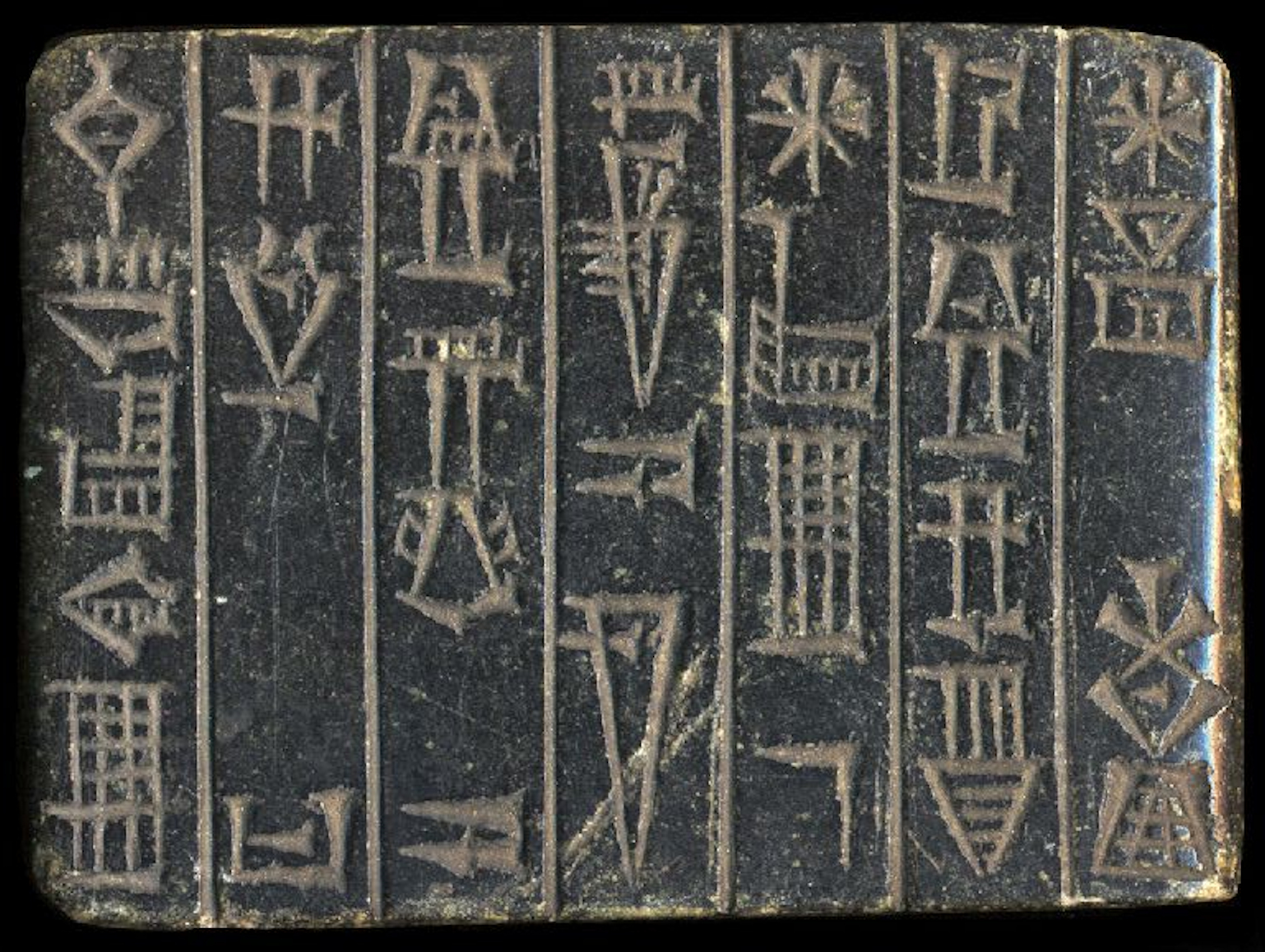|
Isin
Isin (, modern Arabic language, Arabic: Ishan al-Bahriyat) is an archaeological site in Al-Qādisiyyah Governorate, Iraq which was the location of the Ancient Near East city of Isin, occupied from the late 4th millennium Uruk period up until at least the late 1st millennium BC Neo-Babylonian period. It lies about southeast of the modern city of Al Diwaniyah. The tutelary deity of Isin, dating back to at least the Early Dynastic Period (Mesopotamia), Early Dynastic period, was the healing goddess Gula (goddess), Gula with a major temple (, E-gal-ma) sited there as well as smaller installations for the related gods of Ninisina and Ninlil, Sud. Archaeology Isin is located approximately south of the ancient city of Nippur. The site covers an area of about 150 hectares with a maximum height of about 10 meters. By 1922 the site had been suggested as that of Isin. Ishan al-Bahriyat was visited by Stephen Herbert Langdon for a day to conduct a sounding, while he was excavating at K ... [...More Info...] [...Related Items...] OR: [Wikipedia] [Google] [Baidu] |
Al-Qādisiyyah Governorate
Al-Qadisiyah Governorate (, ), also known as the Al-Diwaniyah Governorate (, ), is one of the governorates of Iraq. It is in the southern part of the center of the country. The estimated population of the province is about a million and a half million people, according to the census of 2014. Its capital is Al Diwaniyah. Before 1976, it was part of the ad-Diwāniyah Governorate, along with al-Muthannā and Najaf. The province is named after the historical city of Al-Qadisiyah, the site of the Battle of al-Qadisiyyah, where in 636 CE the Islamic Rashidun forces defeated the forces of the Sassanid Empire. The governorate is predominantly Shia Arab. It includes the Mesopotamian Marshes of Hor Aldelmj. Education There is one public university known as the University of Qadisiyah, which was founded in the late 1980s, and includes colleges such as nursing, pharmacy, law, literature, education, agriculture, medicine and others. The student population is mostly derived from distric ... [...More Info...] [...Related Items...] OR: [Wikipedia] [Google] [Baidu] |
Kish (Sumer)
Kish (Sumerian language, Sumerian: Kiš; transliteration: :wikt:𒆧, KišKi (earth), ki; cuneiform: ; , near modern Tell al-Uhaymir) is an important archaeological site in Babil Governorate (Iraq), located south of Baghdad and east of the ancient city of Babylon. The Ubaid period site of Ras al-Amiyah is away. It was occupied from the Ubaid period to the Hellenistic period. In Early Dynastic times the city's patron deity was Ishtar with her consort Ea (Babylonian god), Ea. Her temple, at Tell Ingharra, was (E)-hursag-kalama. By Old Babylonian times the patron deity, patron deities had become Zababa, along with his consort, the goddess Bau (goddess), Bau and Istar. His temple Emeteursag (later Ekišiba) was at Uhaimir. History Kish was occupied from the Ubaid period (c.5300–4300 BC), gaining prominence as one of the pre-eminent powers in the region during the Early Dynastic Period (Mesopotamia), Early Dynastic Period when it reached its maximum extent of 230 hectares. [...More Info...] [...Related Items...] OR: [Wikipedia] [Google] [Baidu] |
Hymn Iddin-Dagan Louvre AO8864
A hymn is a type of song, and partially synonymous with devotional song, specifically written for the purpose of adoration or prayer, and typically addressed to a deity or deities, or to a prominent figure or personification. The word ''hymn'' derives from Greek (''hymnos''), which means "a song of praise". A writer of hymns is known as a hymnist. The singing or composition of hymns is called hymnody. Collections of hymns are known as hymnals or hymn books. Hymns may or may not include instrumental accompaniment. Polyhymnia is the Greco/Roman goddess of hymns. Although most familiar to speakers of English in the context of Christianity, hymns are also a fixture of other world religions, especially on the Indian subcontinent ('' stotras''). Hymns also survive from antiquity, especially from Egyptian and Greek cultures. Some of the oldest surviving examples of notated music are hymns with Greek texts. Origins Ancient Eastern hymns include the Egyptian ''Great Hymn to the Aten'' ... [...More Info...] [...Related Items...] OR: [Wikipedia] [Google] [Baidu] |
Ur-du-kuga
Ur-dukuga, written d''ur-du''6''-kù-ga'', c. 1830–1828 BC ( MC), was the 13th king of the Dynasty of Isin and reigned for 4 years according to the ''Sumerian King List'',''Sumerian King List'', Ashm. 1923.344 the ''Blund-Wendell'' prism. 3 years according to the ''Ur-Isin kinglist''.''Ur-Isin kinglist'', tablet MS 1686 line 18. He was the third in a sequence of short reigning monarchs whose filiation was unknown and whose power extended over a small region encompassing little more than the city of Isin and its neighbor Nippur. He was probably a contemporary of Warad-Sîn of Larsa and Apil-Sîn of Babylon. Biography He credited Dāgan, a god from the middle Euphrates region who had possibly been introduced by the dynasty’s founder, Išbi-Erra, with his creation, in conesCones LB 990, NBC 6110, 6111, 6112. commemorating the construction of the deity’s temple, the Etuškigara, or the house “well founded residence,” an event also celebrated in a year-name. The inscrip ... [...More Info...] [...Related Items...] OR: [Wikipedia] [Google] [Baidu] |
Adad-apla-iddina
Adad-apla-iddina, typically inscribed in cuneiform mdIM- DUMU.UŠ-SUM''-na'', mdIM-A-SUM''-na'' or dIM''-ap-lam-i-din-'' 'nam''meaning the storm god “Adad has given me an heir”, was the 8th king of the 2nd Dynasty of Isin and the 4th Dynasty of Babylon and ruled 1064–1043. He was a contemporary of the Assyrian King Aššur-bêl-kala and his reign was a golden age for scholarship. Biography Provenance The broken obelisk of Aššur-bêl-kala relates that the Assyrians raided Babylonia, early in his reign: Depending on the exact synchronization of the Assyrian and Babylonian chronologies, this would have been shortly before, or at the very beginning of Adad-apla-iddina’s reign. His ancestor ''Esagil-Šaduni'' is named in the ''Synchronistic History''The ''Synchronistic History'' (ABC 21) column 2 lines 31 to 37. as his “father”, but he was actually ”a son of a nobody,” i.e. without a royal parent. This chronicle recounts that he was appointed by the Assyrian k ... [...More Info...] [...Related Items...] OR: [Wikipedia] [Google] [Baidu] |
Malgium
Malgium (also Malkum) (Ĝalgi’a or Ĝalgu’a in Sumerian, and Malgû(m) in Akkadian) is an ancient Mesopotamian city tentatively identified as Tell Yassir (one of a group of tells called collectively Tulūl al-Fāj) which thrived especially in the Middle Bronze Age, ca. 2000 BC - 1600 BC.Frayne, Douglas, "Malgium", Old Babylonian Period (2003–1595 BC). Volume 4, The Royal Inscriptions of Mesopotamia: Early Periods, University of Toronto Press, pp. 668–670, 1990 Malgium formed a small city-state in an area where the edges of the territories controlled by Larsa, Babylon and Elam converged. Inscribed in cuneiform as ma-al-gi-imKI, its chief deities were Ea (whose temple was called Enamtila) and Damkina.De Boer, Rients, "An early Old Babylonian archive from the kingdom of Malgium?", Journal Asiatique 301.1, pp. 19-25, 2013 A temple of Ulmašītum is known to have been there. There was also a temple to the goddess Bēlet-ilī called Ekitusgestu as well as a temple to the god ... [...More Info...] [...Related Items...] OR: [Wikipedia] [Google] [Baidu] |
Manishtushu
Manishtushu (Man-ištušu) (, ''Ma-an-ish-tu-su''; died 2255 BC) was the third (or possibly second) king of the Akkadian Empire, reigning 15 years c. 2270 BC until his death c. 2255 BC. His name means "Who is with him?". He was the son of Sargon of Akkad, Sargon the Great, the founder of the Akkadian Empire, and he was succeeded by his son, Naram-Sin of Akkad, Naram-Sin who also deified him posthumously. A cylinder seal, of unknown provenance, clearly from the reign of Naram-Sin or later, refers to the deified Manishtushu i.e. "(For) the divine Man-istusu: Taribu, the wife of Lugal-ezen, had (this seal) fashioned". Texts from the later Ur III period show offerings to the deified Manishtushu (spelled ᵈMa-iš-ti₂-su or ᵈMa-an-iš-ti₂-su). The same texts mention a town of ᵈMa-an-iš-ti₂-su where there was a temple of Manishtushu. This temple was known in the Sargonic period as Ma-an-iš-t[i-s]uki. Biography Manishtushu was the third king of the Akkadian Empire accordi ... [...More Info...] [...Related Items...] OR: [Wikipedia] [Google] [Baidu] |
Ninurta
Ninurta (: , possible meaning "Lord [of] Barley"), also known as Ninĝirsu (: , meaning "Lord [of] Girsu"), is an List of Mesopotamian deities, ancient Mesopotamian god associated with farming, healing, hunting, law, scribes, and war who was first worshipped in early Sumer. In the earliest records, he is a god of agriculture and healing, who cures humans of sicknesses and releases them from the power of Demons#Mesopotamia, demons. In later times, as Mesopotamia grew more militarized, he became a warrior deity, though he retained many of his earlier agricultural attributes. He was regarded as the son of the chief god Enlil and his main Cult (religious practice), cult center in Sumer was the Eshumesha temple in Nippur. Ninĝirsu was honored by Gudea, King Gudea of Lagash (ruled 2144–2124 BC), who rebuilt Ninĝirsu's temple in Lagash. Later, Ninurta became beloved by the Assyrians as a formidable warrior. The Assyrian king Ashurnasirpal II (ruled 883–859 BC) built a massive tem ... [...More Info...] [...Related Items...] OR: [Wikipedia] [Google] [Baidu] |
Iraq War
The Iraq War (), also referred to as the Second Gulf War, was a prolonged conflict in Iraq lasting from 2003 to 2011. It began with 2003 invasion of Iraq, the invasion by a Multi-National Force – Iraq, United States-led coalition, which resulted in the overthrow of the Ba'athist Iraq, Ba'athist government of Saddam Hussein. The conflict persisted Iraqi insurgency (2003–2011), as an insurgency arose against coalition forces and the newly established Iraqi government. US forces Withdrawal of United States troops from Iraq (2007–2011), were officially withdrawn in 2011. In 2014, the US became re-engaged in Iraq, leading a new coalition under Combined Joint Task Force – Operation Inherent Resolve, as the conflict evolved into the ongoing Islamic State insurgency in Iraq (2017–present), Islamic State insurgency. The Iraq invasion was part of the Presidency of George W. Bush, Bush administration's broader war on terror, launched in response to the September 11 attacks. ... [...More Info...] [...Related Items...] OR: [Wikipedia] [Google] [Baidu] |
Gulf War
, combatant2 = , commander1 = , commander2 = , strength1 = Over 950,000 soldiers3,113 tanks1,800 aircraft2,200 artillery systems , page = https://www.govinfo.gov/content/pkg/GAOREPORTS-PEMD-96-10/pdf/GAOREPORTS-PEMD-96-10.pdf , strength2 = 1,000,000+ soldiers (~600,000 in Kuwait)5,500 tanks700+ aircraft3,000 artillery systems , casualties1 = Total:13,488 Coalition:292 killed (147 killed by enemy action, 145 non-hostile deaths)776 wounded (467 wounded in action)31 tanks destroyed/disabled28 Bradley IFVs destroyed/damaged1 M113 APC destroyed2 British Warrior APCs destroyed1 artillery piece destroyed75 aircraft destroyedKuwait:420 killed 12,000 captured ≈200 tanks destroyed/captured 850+ other armored vehicles destroyed/captured 57 aircraft lost 8 aircraft captured (Mirage F1s) 17 ships sunk, 6 captured. Acig.org. Retrieved on 12 June 2011 , casualties2 = Total:175,000–300,000+ Iraqi:20,000–50,000 killed ... [...More Info...] [...Related Items...] OR: [Wikipedia] [Google] [Baidu] |
Nebuchadnezzar II
Nebuchadnezzar II, also Nebuchadrezzar II, meaning "Nabu, watch over my heir", was the second king of the Neo-Babylonian Empire, ruling from the death of his father Nabopolassar in 605 BC to his own death in 562 BC. Often titled Nebuchadnezzar the Great, he is regarded as the empire's greatest king, famous for his military campaigns in the Levant and their role in Jewish history, and for his construction projects in his capital of Babylon, including the Hanging Gardens of Babylon. Ruling for 43 years, Nebuchadnezzar was the longest-reigning king of the Babylonian dynasty. By the time of his death, he was among the most powerful rulers in the world. Possibly named after Nebuchadnezzar (governor of Uruk), his grandfather of the same name, or after Nebuchadnezzar I ( 1125–1104 BC), one of Babylon's greatest ancient warrior-kings, Nebuchadnezzar II had already secured renown for himself during his father's reign, leading armies in the Medo-Babylonian conquest of the Assyrian Empir ... [...More Info...] [...Related Items...] OR: [Wikipedia] [Google] [Baidu] |






